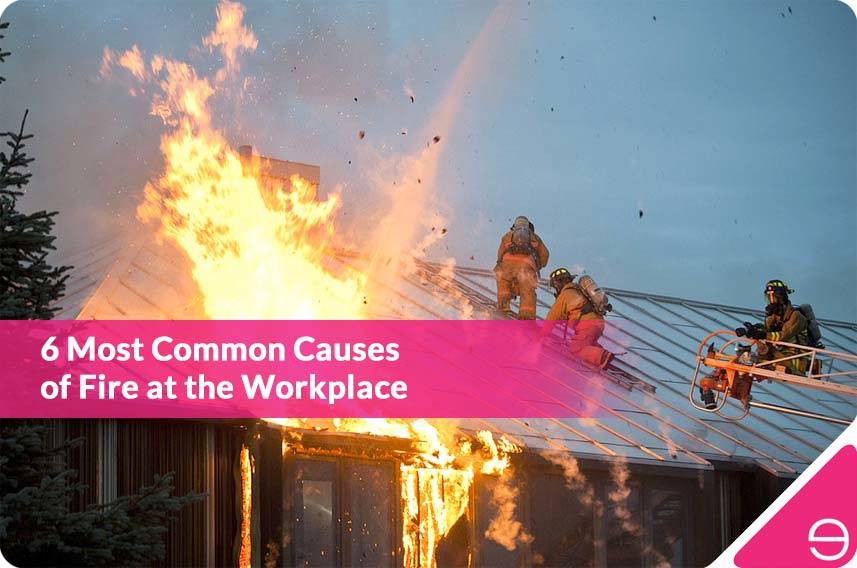The last thing anyone wants to deal with at a workplace is an accident, especially a fire.
Statistics for 2016 and 2017 show that there were over 15,000 reported fires at the workplace, which is a staggeringly high number.
This represents a very serious and dramatic danger that can destroy a business and potentially take human lives.
Prevention is absolutely critical when dealing with the issue of fire safety, and there are many different factors that can be implemented to lessen the risk.
Fires always have a root cause. Destruction and potential loss of life are regrettably the direct result.
There’s plenty of factors that can increase the chances of a fire breaking out. Within this article, we outline the 6 most common causes of fire at the workplace, and what preventative action you can take to lessen the risk of one occurring.
Table of Contents
1. Faulty Electrical Equipment
One of the most common causes of workplace fires is without doubt electrical faults.
They tend to be caused by defective wiring, overloaded sockets or plugs, and equipment that is old and malfunctioning, becoming overwhelmed and leading to sparks that start a fire on combustible materials.
It’s important to note that it is legally applicable for a workplace to ensure that all equipment works and functions correctly, and this includes electrical machinery.
Every year, it is mandatory that a Portable Appliance Test (PAT) be conducted on all electrical equipment at a workplace to ensure it functions properly and is not a safety hazard.
All items that pass the PAT test are labelled with a sticker outlining the date of test and pass.
Knowing all electrical equipment at work functions fully and is in correct working order is vitally important to fire prevention.
Having PAT tests carried out regularly will go a long way to reducing the risks associated with electrical fires.
2. Clutter
Clutter is a common issue in offices and if regular cleaning and maintenance is not carried out, it will eventually increase the odds associated with a fire breaking out.
The office is full with combustable materials and fire hazards.
Ranging from a simple built up dust, grease, and overloaded refuse areas, to built up dirt and poorly ventilated areas can cause machinery and equipment to become overwhelmed with heat which can lead to a fire.
A regular cleaning regime and ensuring work areas are at an optimal state is integral for reducing potential fire risks.
Actively encouraging employees to keep their working environments as clean and tidy as possible will help to mitigate the risk of a fire breaking out hugely.
 3. Combustible Materials
3. Combustible Materials
It goes without saying that if your workplace stores or uses flammable or combustible materials, that safety must be of prime importance for both employees and the management of those materials.
If a workplace is known to utilise combustible material then correct storage, disposal and handling processes must be highly regulated and safety must be considered paramount for all workers.
Proper education and training on handling combustible and flammable materials must be done regularly.
4. Human Error
Another major reason for fires inside the workplace is basic human error.
This is typically because of incidents that were not intentional.
A number of things can happen in a variety of ways including burning food in a staff area, spilling flammable liquids, improper use of machinery or equipment that overheats, and simple carelessness.
One method to prevent these types of incidents from escalating is to ensure there’s plenty of suitable fire extinguishers located around the work area.
It’s also important that all employees are properly trained on how to use fire extinguishers and to regularly address and assess any potential risks in the workplace that could happen due to human error.
5. Negligence
Sadly, there are plenty of opportunities for fires to start at work due to negligence and lack of care.
In an attempt to get a task done quicker, short cuts have been known to be taken where certain workers have chosen to ignore correct procedures to get the job done faster, which could indirectly cause a major fire and health and safety risk.
Example being the blocking of ventilation areas, stacking paper or card in a flammable area, misusing or improperly storing flammable or combustible materials, or overusing equipment or using equipment improperly.
To help avoid these known issues, it’s imperative to train your employees appropriately.
Business owners should conduct reviews, retraining and assessments at regular intervals to ensure proper workmanship and reduce any risk of fires in the future.
6. Arson
Unfortunately, arson and the deliberate act of starting fires is not as rare as some may believe.
Industrial and commercial businesses for example, have been known to be targeted by vandals. However, there are methods to help prevent this.
The first method to prevent criminals from causing fires is to use close circuit television cameras and motion sensor lights as a detergent.
In most cases, a suitable security system will make would be vandals think twice.
Another method to help deal with a potential fire is to have an interior anti-fire sprinkler system installed, especially in areas that are higher risk.
This can help limit the damage if a fire broke out, and prevent any fires from spreading to different parts of the building.
Being able to prevent fire in the workplace is something that must be taken seriously, evaluated and addressed correctly.
Training employees on fire safety and following the fire prevention methods outlined above can reduce the risks and chances of fire in the workplace hugely.


